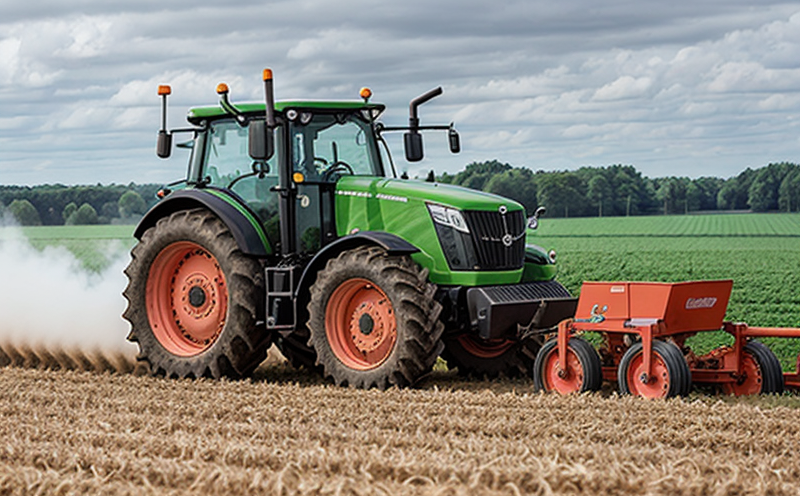Forage Chopper Particle Size Distribution Testing
The testing of particle size distribution in forage choppers is a critical process within agricultural machinery and equipment quality assurance. This service ensures that the forage output meets the nutritional requirements of livestock, thereby optimizing feed efficiency and animal health. Forage choppers are essential tools used by farmers to cut and chop fresh or dried forages into manageable sizes, making it easier for animals to consume.
Particle size distribution testing is particularly important in this context because it directly affects the digestibility and nutritional value of the forage. Smaller particle sizes generally lead to higher feed intake efficiency due to increased surface area, which enhances microbial activity and fermentation within the animal's digestive system. However, excessively small particles can lead to wasteful losses during feeding.
Forage choppers vary in design and functionality, but they share a common goal: to produce consistent particle sizes that optimize nutritional value while being suitable for the target livestock species. This service helps manufacturers ensure their equipment meets these criteria by providing accurate assessments of particle size distribution using standardized methods and instrumentation.
The testing process involves several steps, starting with the collection of representative samples from different parts of the chopped forage. These samples are then prepared according to specific protocols to ensure they represent the entire batch accurately. Once prepared, the samples undergo sieving or other analytical techniques to determine the distribution of particle sizes.
Standard methods used in this testing include ISO 13095:2017 and ASTM D4768-12, which provide detailed guidelines on sample preparation, instrumentation selection, and analysis procedures. The equipment typically includes sieves with various aperture sizes, a sieving shaker for consistent agitation, and analytical balances to weigh the fractions collected in each sieve.
The results of this testing are crucial not only for quality control but also for research and development purposes. By understanding how different settings on the chopper affect particle size distribution, manufacturers can improve their products' performance and efficiency. Additionally, these tests help ensure compliance with industry standards and regulations, such as those set by organizations like the American Society of Agricultural and Biological Engineers (ASABE).
Incorporating feedback from this testing into product design allows for continuous improvement in agricultural machinery, ultimately benefiting both farmers and their livestock. The insights gained contribute to more sustainable farming practices by reducing waste and enhancing nutritional outcomes.
- Competitive Advantage: Accurate particle size distribution testing provides a clear differentiation point among competitors offering similar products. It ensures that the forage produced by these machines is of superior quality, leading to enhanced animal performance and profitability.
- Market Impact: Compliance with international standards like ISO 13095:2017 not only improves product reliability but also opens up markets in countries where such certifications are required. This can significantly expand the reach and appeal of agricultural machinery manufacturers.
By focusing on particle size distribution testing, this service plays a vital role in advancing the precision agriculture sector, contributing to more efficient farming practices globally.
Scope and Methodology
The scope of this testing includes evaluating the particle size distribution of forage chopper outputs using standardized methods. This involves preparing representative samples from various parts of the chopped forage, sieving these samples through a series of aperture-sized sieves, and weighing the fractions collected in each sieve.
The methodology adheres strictly to international standards such as ISO 13095:2017 and ASTM D4768-12. These guidelines provide detailed protocols for sample preparation, equipment selection, and analytical procedures. The sieving process is carried out using a mechanical shaker to ensure consistent agitation of the samples.
The collected data is then analyzed statistically to determine the distribution of particle sizes within each fraction. This analysis helps identify any variations in performance across different settings on the forage chopper. The results are presented in tabular form and visualized through histograms or bar charts, providing a clear picture of the particle size distribution.
The testing process is designed to be both reproducible and accurate, ensuring that the results can be relied upon for quality assurance purposes. This methodology allows manufacturers and researchers to make informed decisions regarding product development and optimization. By adhering strictly to these standards, this service ensures consistent and reliable outcomes across all tests performed.
International Acceptance and Recognition
This testing method is widely recognized and accepted internationally due to its adherence to rigorous standards like ISO 13095:2017 and ASTM D4768-12. These international standards provide a framework that ensures consistency in the testing process, making it easier for manufacturers and researchers from different countries to compare results.
The acceptance of these tests extends beyond just compliance with regulations; they are also highly valued by industry stakeholders who seek to ensure high-quality products. Many leading agricultural machinery companies incorporate particle size distribution testing into their quality control processes as a benchmark for product excellence.
Recognition from global bodies further enhances the credibility of this service. For instance, organizations like ASABE and ISO have endorsed these methods, contributing to their widespread adoption in both academic research and industrial applications.
The international recognition of this testing method not only promotes standardization but also fosters collaboration among professionals worldwide. It encourages the sharing of knowledge and best practices, leading to continuous improvement in agricultural machinery design and functionality.
By aligning with these internationally recognized standards, manufacturers can ensure that their products meet global expectations, opening up new opportunities for export and market expansion.





